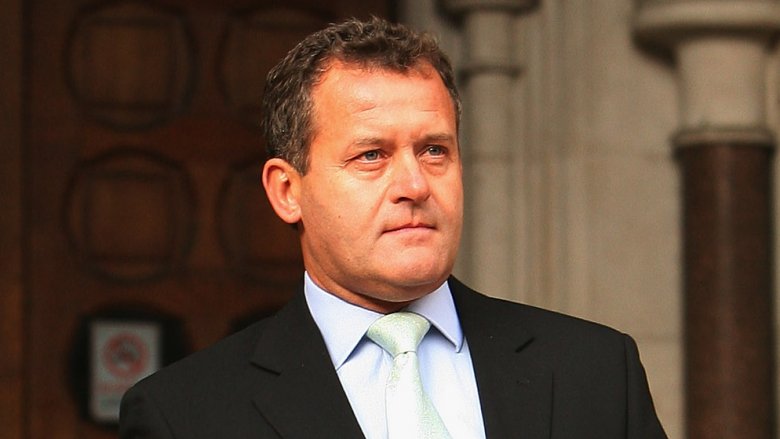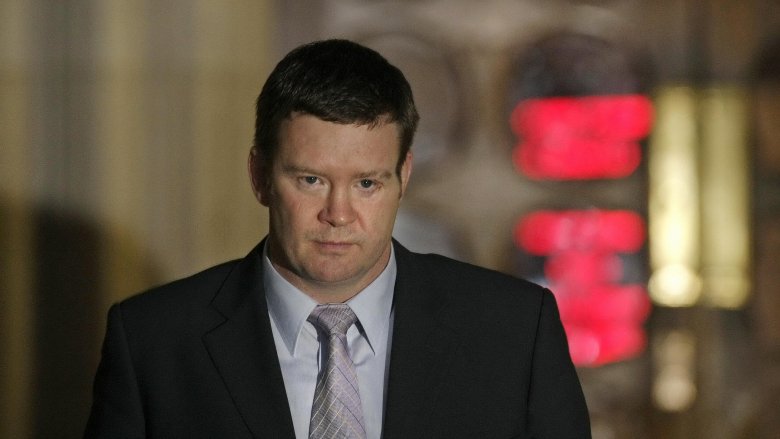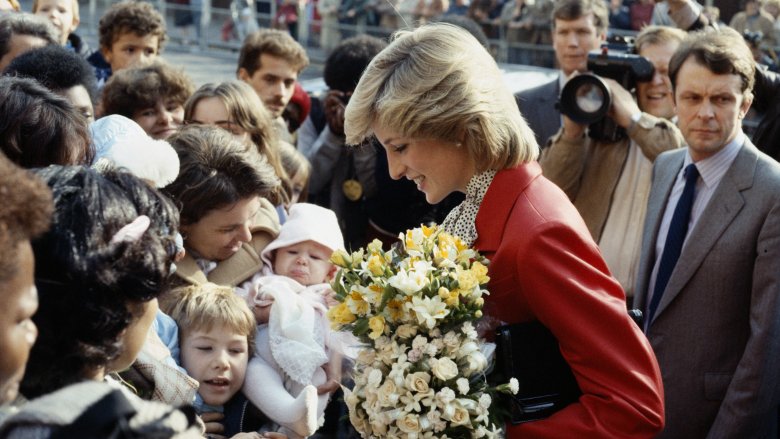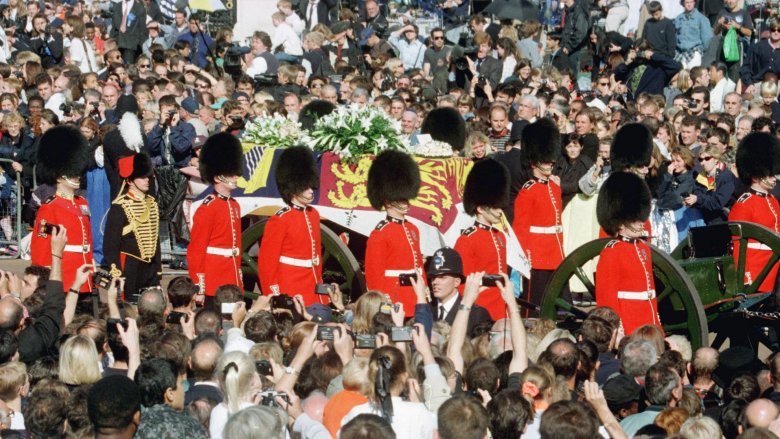Things That Never Made Sense About Princess Diana's Death
Beloved by millions, Diana, Princess of Wales, brought beauty, grace, and compassion to a suffering world. From her tireless charity work to her standing at the forefront of the HIV/AIDS epidemic, Diana was a beacon of light and hope to those without a voice.
On the night of Aug. 31, 1997, the 36-year-old royal was fatally injured in a car crash while riding through the Pont de l'Alma tunnel in Paris, France. The crash also claimed the lives of her boyfriend, billionaire and Harrods' heir Dodi al-Fayed, 42, and their driver, Henri Paul, 41. The official version of events states Paul was driving at a high speed while under the influence, but more than 20 years after her death, questions and conspiracy theories abound about what truly happened that night. Let's take a closer look at some things that just don't make sense.
She wrote a letter to a friend predicting her death
Reportedly calling him ”the only man I can trust," Princess Diana wrote a letter to her friend and former butler, Paul Burrell, claiming there was a sinister plot to kill her. Diana laid out her suspicions in full. "This particular phase in my life is the most (the word most is underlined) dangerous," she wrote (via the Daily Mail). "(Word here blacked out) is planning 'an accident' in my car, brake failure and serious head injury in order to make the path clear for Charles to marry."
Ten months later, her premonition came true. Whether this letter was paranoia or credible evidence is up for debate, but along with the other mysteries surrounding her death, her written words lend credence to those who think there's far more to this story.
The car they intended to take that night wouldn't start
Government documents (obtained under the Freedom of Information Act), revealed that the vehicle Princess Diana and al-Fayed were originally supposed to ride in that fateful night had broken down at the Paris Ritz. According to a memo included in the documents (via the Independent), "their getaway car failed to start, they got into another nearby car driven by a Ritz driver." Other documents reportedly claim the couple simply had a "last-minute change of plan aimed at diverting the paparazzi."
Did their original car actually break down, or was this an act of sabotage to redirect the Princess of Wales and al-Fayed into the ill-fated Mercedes? We may never the truth.
A witness claims 'other forces' were behind the crash
Decades after the fatal crash, eyewitness and retired lawyer Stanlee Culbreath came forward to provide new details surrounding the immediate aftermath of the scene.
In an interview with the Mirror, Culbreath criticized and questioned the French emergency services' response time, wondering if the first responders contributed to Diana's death. "I always thought it was suspicious, that other forces played a hand, but now, 20 years on, I question more than ever whether it was a genuine accident. I just think it is dubious. If that's the Princess, why did it take 20 minutes or so to get to her and, when she was finally released [from the car], why did they pass one hospital and take her to another?"
Culbreathe continued, "there are so many questions I ask myself over and over again about how the accident was handled and if she could have been saved. I pleaded for the police to help, but they were very nonchalant about the entire thing... It could have been up to 30 minutes before help came. We were there for at least 15 minutes. Why wasn't an ambulance there quicker?"
Again, more questions; not enough answers.
The ambulance was instructed to drive slowly
According to The Guardian, ambulance driver Michel Massebeuf "contradicted claims that the journey to [the] hospital through central Paris was prolonged as part of a conspiracy to kill Diana."
The princess was reportedly treated by a doctor at the scene for roughly 40 minutes instead of being immediately rushed to a hospital. When she was transported, Massebeuf was reportedly instructed to pass by the closest hospital and drive slowly to another hospital. Massebeuf told an inquest jury, "The doctor instructed me to drive slowly because of the condition of the princess... I should point out that driving slowly is a rule, the sole objective of which is to preserve a casualty where necessary."
At one point, the onboard doctor, Jean-Marc Martino, reportedly ordered the ambulance to come to a complete stop because Diana's blood pressure dropped: "We stopped for about five minutes, in order for him to be able to provide treatment that required a complete absence of movement," Massebeuf said. "We continued our journey without having to stop again."
According to The Guardian, Diana went into cardiac arrest around 2:10 a.m. and was pronounced dead at 4 a.m.
Dodi al-Fayed's bodyguard says the driver was drunk
Trevor Rees-Jones, al-Fayed's personal bodyguard, was the sole survivor of the crash but "suffered severe brain and chest injuries and every bone in his face was broken," reported The Sun. "Surgeons used 150 pieces of titanium to rebuild his smashed face, using family photos as a guide."
After spending ten days in a coma, Rees-Jones was unclear about many details surrounding the crash, but he was sure of one thing: the driver was allegedly intoxicated. According to the Daily Mail, Rees-Jones claims, "the accident happened because Henri Paul was taking alcohol and was driving the vehicle. That's why the accident happened." The official autopsy backed Rees-Jones' claims, revealing that Paul's blood alcohol limit was reportedly twice the legal limit.
However, al-Fayed's father, Mohamed Fayed, doesn't believe Rees-Jones and has accused his son's bodyguard of "working for the secret intelligence services," suggesting the blood samples were "switched or contaminated by secret agents," the Daily Mail reported.
According to the Daily Mail, CCTV footage taken moments before getting behind the wheel shows Paul "tying his shoe laces with no evidence that alcohol had led to impairment of his movement."
Another question worth asking among all this finger-pointing: If you're pulling security for a billionaire heir and his royal girlfriend, why get into a vehicle with someone who was reportedly "drunk as a pig?"
Henri Paul interrogated a mysterious person at the Ritz
Henri Paul's father, Jean Paul, says the whole world has made an "arch scapegoat" of his son. Jean told the Daily Mail that his son interrogated and then kicked out a mysterious intruder who was seen hanging around The Ritz the night of the crash.
"This man was not a customer, he was a curieux [nosy parker] and it was Henri's job to have him ejected," Jean said. "Henri had this taken care of quietly. This was told to me by someone at the Ritz and there were two witnesses. A report had been made to the reception desk about this man and Henri had been called in to deal with the matter."
Some suspect this trespasser could have been part of an alleged plot to kill Princess Diana, or perhaps the intruder was actually someone Henri knew well. Let's take a closer look...
Henri Paul had close to $200K among 15 bank accounts
According to the Daily Mail, Henri Paul was a "modestly paid bachelor" with a security job at the Ritz Paris, so why did he reportedly have close to $200,000 among 15 bank accounts and $1,400 in cash on him at the time of his death? Mohamed al-Fayed claims this "cash shows Paul was in the pay of MI6 or another foreign security service."
Paul's father doesn't buy that: "I was as surprised as anyone about the mysterious bank accounts and I have been hurt by the insinuations that my son was paid money by the secret services,' he said (via the Daily Mail). "It doesn't add up, because in the months leading up to his death he asked us to lend him some money to buy a flat in Paris. If he had that amount of money in his bank accounts, would he have come humbly cap-in-hand to his old dad asking for a loan of about ten thousand francs?"
Another conspiracy theory alleges Paul may have been employed by the paparazzi on the side. Alas, the answers to these questions died with him.
A witness reported a 'major white flash' before the crash
Francois Levistre, who was driving in front of the Mercedes carrying Diana and al-Fayed in the Pont de l'Alma underpass, claims the car was "overtaken by a motorcycle" before the crash. Speaking to the Telegraph, Levistre describes what he saw in his rear-view mirror: "I realized there was this major white flash of the motorbike in front of the Mercedes... When I saw the light, I looked into the mirror... I saw the car going from left to right to left again to get within the pillar. The car had no light any longer. Everything was switched off." Leviste said the motorcycle's passenger jumped off then "looked inside the car and made a hand gesture to the bike's driver before the pair drove away."
France has a Good Samaritan Law, so why did the motorcycle's driver and passenger flee the scene instead of stopping to help. Were they another cog in the alleged machine to end Diana's life, or were they in the wrong place at the wrong time and simply panicked?
Were Diana and Dodi murdered to stop their engagement?
Mohamed al-Fayed said his son planned to give Diana an engagement ring on the night of the crash, and the happy couple intended to announce its engagement to the world the following day. According to the Express, al-Fayed believes the impending nuptials provided the impetus for the Royal Family and MI6 to begin a "conspiracy to murder the princess" in order to "stop news of the engagement getting out." Al-Fayed claims this information was obtained "through telephone monitoring."
In 2004, the Metropolitan Police Service launched Operation Paget to investigate conspiracy theories surrounding Diana's death. The operation reportedly studied al-Fayed's theory and issued a report that "concluded the claims were nothing more than a conspiracy theory," reported the Express. "Family members and numerous close friends and associates of the Princess of Wales have been interviewed and none of them was aware of any intention to get engaged or to announce an engagement."
A photographer who followed Diana was shot to death
According to the Express, paparazzi photographer Jean-Paul James Andanson followed Princess Diana relentlessly in the weeks before her death, becoming one of the key figures in assassination plot conspiracy theories. Some believed Andanson's white Fiat Uno clipped the Mercedes on that horrific night in 1997. Despite authorities believing Andanson was "a regular informer for both MI6, the British Secret Intelligence Service, and French agencies," he was not properly interviewed after the fatal crash, reported the Express.
In May 2000, Andanson's body was reportedly found in the back of a burned out BMW in the South of France "so badly charred that it took police nearly a month before DNA and dental records confirmed his identity," the Express reported. His death was ruled a suicide.
However, Christophe Pelat, the fireman who discovered Andanson's body, told the Express, "I saw him at close range and I'm absolutely convinced that he had been shot in the head, twice." When asked to elaborate, Pelat said, "It is not my job to say any more to anybody except the official authorities. I deal with emergencies every day of the week and treat each one with equal importance."
The mysterious white Fiat Uno
Authorities reportedly believe a white Fiat Uno made between 1983 and 1989 was involved in, but not the cause of, the crash that killed Princess Diana. However, the identity of the Fiat's driver remains a mystery.
Conspiracy theorists have linked Andanson to the Fiat Uno that struck Princess Diana's BMW, but according to the Operation Paget report, Andanson was at home with his wife at the time of the crash.
There is another lead: Scotland Yard reportedly think the Fiat's the driver might be Le Van Thanh, a then 22-year-old taxi cab driver who was reportedly interviewed by French police at the scene but quickly dismissed as a suspect. Thanh has refused to be questioned by Scotland Yard multiple times. According to the Daily Mail, Thanh was "known to have been driving in central Paris on the night in question" and "paint on his car matched traces found on the Mercedes." Several witness claim to have seen "a large dog" in the back of the Fiat. Thanh owned a Rottweiler at the time. According to the Mirror, Thanh's father claimed in a 2006 interview that Thanh painted "his white Uno red hours after the accident."
In 2017, Scotland Yard's Lord Stevens told the Daily Mail, "We are still trying to interview him."
Will there ever be closure?
Although every official investigation into Princess Diana's death has stated there was no foul play, conspiracy theories surrounding her death continue to manifest and grow. Pauline Maclaran, co-author of Royal Fever: The British Monarchy in Consumer Culture, told The Associated Press that this kind of reaction is not unusual. "Human nature refuses to believe that something as random as a car accident could kill someone as special as Diana. When you have icons, it's very hard to believe that they can just come to an end in such a futile way."













